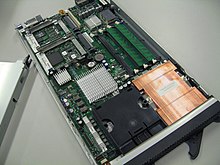Blade server
A blade server , even server blade or short blade ( engl. "Sheet", "blade") is an assembly which, together with the homogeneous a battery not the own computer forms. Blades are used in manufacturer-specific subracks and share the power supplies built into them .
construction
Depending on the manufacturer, the subracks are called BladeCenter or Blade Enclosure , for example , and are usually intended for 19-inch racks . The blades are inserted into so-called slots and are then automatically connected to the backplane of the subrack.
architecture
Blades usually only have their own motherboard with microprocessors , RAM and none, one or two hard drives that are intended for the operating system . If more disk space is required, this can be created either via an adapter in the BladeCenter ( SAN , NAS ) or via an expansion module with hard disks, which itself requires a slot in the BladeCenter.
The blades use the same resources, are managed centrally and have a common power supply and ventilation. For example, a standard 42U 19 ″ rack can hold up to 84 blades and contain up to 7292 processor cores (14784 threads).
A blade system , a name used by HP , provides the connected blades with the complete hardware infrastructure they need. The specialty is that the servers do not have fans in the blades, but the fans are installed redundantly on the rear of the housing. Thus there are no heat fields. The patented fan design originally comes from aircraft technology.
A BladeCenter , a name used by IBM , provides the blades connected to it with the infrastructure they need. In addition to the power supply, this includes a. optical drives, network switches and fiber channel switches (for storage connection). This infrastructure is linked to one or two (redundancy for the purpose of fail-safe) backplanes (midplane).
advantages
The advantage of the blades lies in their compact design, high power density, scalability and flexibility, as well as simpler cabling with significantly less wiring and quick and easy maintenance. In addition, only a single keyboard / graphics mouse controller is required for the rack.
The risk of damage from fan failure is reduced because the fans are housed redundantly in the rack.
disadvantage
Due to the high power density in a small space, planning the power consumption and heat dissipation is not trivial. Due to the compact design, hardware upgrades are more difficult than with conventional tower or rack servers. Blade servers usually have few or no additional PCI and hard disk spaces, which is why many providers provide a storage area network .
Manufacturer
Since 2007 HP has not only been the market leader in Europe , but also worldwide. In the first quarter of 2011, HP had a market share of almost 50%, followed by IBM with 20% and Cisco with 10%. Other manufacturers are Dell , Fujitsu Technology Solutions , Supermicro , Hitachi Data Systems and Oracle .
Web links
Individual evidence
- ↑ a b SDC: blade server. Retrieved October 4, 2018 .
- ↑ IT knowledge: Blade servers. Retrieved October 4, 2018 .
- ↑ IBM BladeCenter HX5 (7873) Product Guide> Lenovo Press. Retrieved October 9, 2017 .
- ↑ Intel® Xeon® Processor E7-8894 v4 (60M Cache, 2.40 GHz) product specifications . In: Intel® ARK (Product Specs) . ( intel.com [accessed October 9, 2017]).
- ↑ a b Large server solutions: Blade servers. April 10, 2012, accessed October 4, 2018 .
- ↑ Blade server: Newcomer Cisco overtakes Dell . Chip Online. May 26, 2011. Archived from the original on May 28, 2011. Info: The archive link was automatically inserted and not yet checked. Please check the original and archive link according to the instructions and then remove this notice. Retrieved February 17, 2012.

